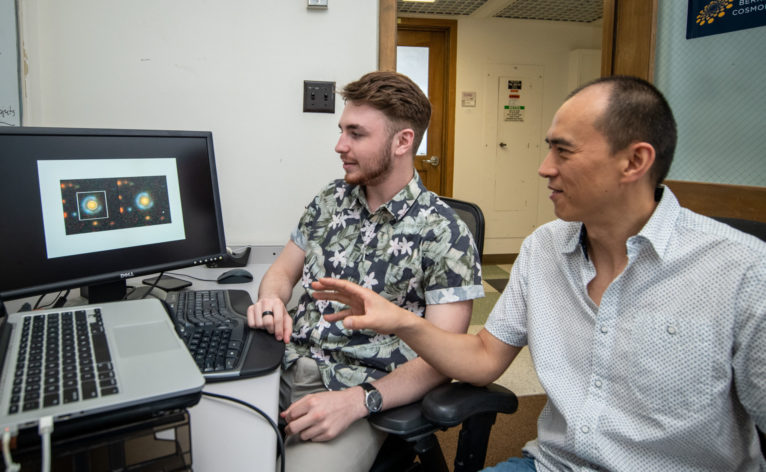How SULI internships have supported the DESI Legacy Imaging Survey

SULI intern Christopher Storfer examines DESI data with one of his mentors, Xiaosheng Huang. (Photo taken by Thor Swift in 2019)
The Workforce Development & Education Department administers eleven internship programs at the Department of Energy’s Lawrence Berkeley National Laboratory (Berkeley Lab). One of the most popular programs is the Department of Energy’s Science Undergraduate Laboratory Internship (SULI). In 2019 alone, 76 interns were enrolled in SULI. While most of the interns contribute research to life on Earth, some of them are focused on what is happening far beyond the distant stars.
One of these interns is Christopher Storfer. He works as a post-baccalaureate researcher on the DESI Legacy Imaging Surveys. The DESI Legacy Imaging Surveys are a massive dataset collected from the Cerro Tololo Inter-American Observatory (CTIO) and the Kitt Peak National Observatory (KPNO). The dataset can be used to find instances of gravitational lensing, a deflection of light due to rare alignment between a foreground and a background galaxy, which allows scientists to learn about more dark matter and the expansion of the universe. As a SULI intern, Storfer was tasked with creating a machine-learning algorithm in order to identify galaxy-galaxy gravitational lensing from within the DESI survey data. He works closely with his mentors, David Schlegel, a senior scientist in Berkeley Lab’s Physics Division and Xiaosheng Huang, an associate professor at the University of San Francisco.
Storfer began to work on the project in 2018. He is now one of the senior interns on the DESI Survey. Unusually, the DESI strong lens search team is made up almost entirely of undergraduates. The team has worked remotely for much of the project. As Storfer explains, “Part of the group is from Berkeley, part of the group is from San Francisco. [Working remotely] was pretty seamless for us.” Communication is a key value for the DESI group. The team meets weekly and checks in with each other over ZOOM. “There’s always an exchange of ideas,” Storfer observes, “We work off of each other’s strengths.”
Over the last three years, Storfer has learned a lot from both his work with Schlegel and Huang. “[Schlegel] has a wealth of experience and wisdom which he has shared with me,” Storfer reflects, “He’s played an instrumental role in my development as a scientist, serving as an example of what is expected of a DOE scientist.” In 2019, Storfer worked directly across from Schlegel’s office. “When he was in his office,” Storfer fondly remembers, “[Schlegel’s] doors were always open and he would always have a smile on his face when I would stop by.” At the time, the team was still trying to work through the first steps of their project and decide how to handle the DESI Legacy Surveys data. “[Schlegel] was more than willing and often very excited,” Storfer recalls, “to take time out of his day to explain [to me] details about the survey and data.”
Working alongside Huang has been similarly valuable. “[Huang] taught me how to be a better scientist,” Storfer says, “to be more precise in my methodology [and] how to manage my workflow.” Like Schlegel, Huang and Storfer regularly touch base. In addition to the weekly meetings, Huang and Storfer have daily check-ins. “I think it’s an unique experience,” Storfer reflects, “I haven’t heard from other people that I know [about] having constant communication with a mentor and I really appreciate it.” Huang was impressed by Storfer’s incredible work ethic early in the project. Even though there were challenges at the beginning of their research, Storfer was always eager to find solutions. As Storfer progressed on the project, Huang found opportunities to loop him into other areas and show him how to manage large scientific collaborations. “I try to get him involved in as many relevant aspects of the project as possible,” Huang explains.
In 2018, when the DESI strong lens search project started, only 300 gravitational lenses had ever been confirmed by astronomers. Now, the DESI team has used machine learning techniques to identify more than 1,500 unique lenses. Huang explains that this project is a part of the DOE’s mission to “transform our understanding of nature.” “Discovering so many strong lenses will potentially transform our understanding of dark matter,” he observes, “and possibly contribute significantly to the understanding of dark energy, too, e.g., through the time delay measurement of the Hubble constant (the cosmic expansion rate).” Storfer’s work with the group has changed his understanding of scientific research, too; he says that his time as a SULI intern helped him realize that he wanted to pursue a career in astronomy. Storfer is a first-generation college student. He will be the first in his family to pursue a PhD. Both Huang and Schlegel gave Storfer valuable advice and helped him apply to doctoral programs. Now, Storfer has accepted a position as a doctoral student at the University of Hawaii’s Institute for Astronomy. Storfer has greatly appreciated his time as an intern. He is grateful to have had the opportunity to work with Schlegel and Huang. It’s been so important to his professional growth, Storfer notes, to have mentors like Schlegel and Huang, who take “the time to help their mentee personally and to do so with joy.”
Even though Storfer is leaving, Huang looks forward to mentoring more interns through programs like SULI. “You watch [an undergraduate] grow as a researcher,” Huang notes, “And that’s pretty exciting.” For researchers like Schlegel and Huang, today’s interns will be tomorrow’s colleagues. Helping an intern discover their own potential can be just as exciting as mapping faraway galaxies.
–Ingrid Ockert, Marketing Communications Coordinator

